We may receive a commission when you use our affiliate links. However, this does not impact our recommendations.
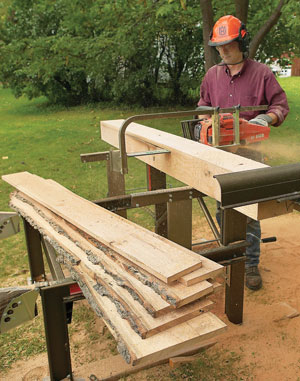
Backyard Sawmills
We all love wood, whether it’s a wide clear board or a gnarly slab with wild grain. That’s why sawing our own lumber crosses the minds of most woodworkers. It might be inspired by the sight of a big tree blown down by a storm, a custom tabletop made from only one or two slabs of unusual wood or the thought of free wood. Whatever reason, the idea of do-it-yourself lumber making holds a certain amount of intrigue for most of us.
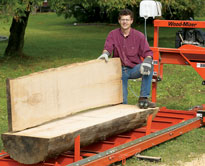
Yielding to my own curiosity about lumber making, I checked out nine sawmills ranging in size from very small to medium. The mills fall into two broad groups: handheld and frame-mounted.
Two Types of Mills
Hand-Held: Most handheld mills fit into the trunk of a car and are easy to carry into the forest or to wherever you plan to cut your lumber. They range in weight from 7 to 45 lbs. and in price from $90 to $1,600—excluding a chainsaw, which they all use. I used a Huskavarna 385XP ($800) for power. It’s has about 85 cc. You can get by with a smaller chainsaw, but it may test your patience. Handheld mills have the distinct advantage of being lightweight and extremely portable.
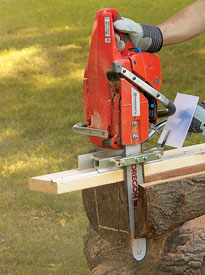
Frame-Mounted: Frame-mounted mills stand on the ground. They weigh from 85 to 1,900 lbs. and must be towed or hauled in a trailer or pickup truck. They range in price from $2,000 to $5,700 for an entry-level machine.

Granberg International Mini Mill II
The Mini Mill II attaches directly to the chainsaw bar with two bolts. The mill follows a metal guide strip that you screw onto a 2×6 guide board. The mill comes with six 2-ft. sections of guide strips, but you can purchase more. The guide board mounts to the log with two nails at each end and must be reattached for each cut. The upside to attaching the guide board each time is that each cut will be as straight as the guide board. I found the vertical operating position surprisingly comfortable, because you do almost all the pushing with your arms and legs rather than your back. I raised the log on a pair of supports to keep the tip of the chainsaw bar from hitting the ground. I made this 8-in. x 8-in. x 8-ft. oak beam in about 20 minutes.

Cost: $90, without chainsaw.
Weight: 7 lbs., without chainsaw.
Maximum log diameter: Chainsaw bar length minus 2 to 4 in.
Maximum cutting width: Chainsaw bar length minus 2 to 4 in.
Maximum cutting thickness: Unlimited.
Maximum cutting length: Unlimited.
Recommended chainsaw: 56 cc or larger.
(866) 233-6499, www.granberg.com
Logosol Timberjig
The Timberjig attaches to the same two bolts that hold the chain bar to the saw. It uses a guide board only for squaring the log. After that, the jig’s guide fence follows the cut surface of the log. The mill’s horizontal position allows you to saw a log on the ground without risk of hitting the ground. Or you can raise the log to waist height and saw it without bending over.

Cost: $165, without chainsaw.
Weight: 11 lbs., without chainsaw.
Maximum log diameter: Length of chainsaw bar minus 2 in.
Maximum cutting width: Length of chainsaw bar minus 2 in.
Maximum cutting thickness: 9 in.
Maximum cutting length: Unlimited.
Recommended chainsaw: 56 cc or larger.
(877) 564-6765, www.logosol.com
Granberg International Alaskan MK-III Mill
The Alaskan MK-III Mill comes in five lengths, from the 24-in. model shown here to a lanky 56-in. model for really big logs. The mill attaches to both ends of the chainsaw bar. Dual guide bars provide a wider, more stable guide system than those on other handheld mills. You must be careful, however, not to let the mill tip or ride up while sawing or you will produce an uneven cut, which will affect all future cuts. Pushing the saw through the log requires a good amount of back muscle and cutting a lot of lumber with this mill will give you a serious workout.
Cost: $185 to $245, without chainsaw.
Weight: 16 to 21 lbs., without chainsaw.
Maximum log diameter: 21 to 53 in.
Maximum cutting width: 21 to 53 in.
Maximum cutting thickness: 13 in.
Maximum cutting length: Unlimited.
Recommended chainsaw: 65 cc or larger.
(866) 233-6499, www.granberg.com

The MK-III rides on two 2x4s for the first squaring cuts. The 2x4s are connected to each other with T-track at both ends. The T-track permits the 2x4s to be adjusted for wide or narrow logs.

After the log is squared, the guide bars ride directly on the surface of the log for all future cuts. The guide bars clamp to vertical supports and are adjustable to control the cut’s thickness.
Southeastern Industrial Resources Ripsaw
The Ripsaw handheld bandsaw mill uses a chainsaw engine for power. Its thin 1/16-in. kerf makes the mill much easier than a chainsaw mill to push through a log. You must still be careful not to rock or tip the saw while cutting, because each consecutive cut will be no better than the one before it. Practice and steady hands will limit the problem. If an uneven cut does occur, it’s best to reattach the guide beam and reestablish a straight, flat cut. The Ripsaw comes with two 63-in. guide-beam sections. Additional sections can be purchased.
Cost: $1,589, without chainsaw.
Weight: 45 lbs., without chainsaw.
Maximum log diameter: 20 in.
Maximum cutting width: 14 in.
Maximum cutting thickness: 9 in.
Maximum cutting length: Unlimited.
Recommended chainsaw: 56 cc or larger.
(256) 728-3070, www.ripsaw.com
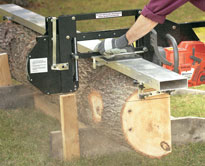
The Ripsaw uses an extruded-aluminum beam as a guide to square the log. This sturdy, straight guide system is the best among those for all the handheld mills I tried. The adjustable mounting brackets make it very easy to level the beam on the log or square it with a previous cut.

I made a ramp stand to get the log off the ground and up to a more comfortable working height. It’s a simple device that’s well worth building.
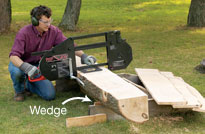
It takes less effort to push the Ripsaw mill through a log than it does a chainsaw mill, because the Ripsaw’s bandsaw blade takes only a 1/16-in. kerf. Wedges screwed to the ramp stand keep the log from rolling during sawing.
Logosol M7 Woodworker’s Mill
The M7 Woodworker’s Mill uses a chainsaw mounted to a guide beam to cut lumber. The log is raised by a crank-and-ratchet system and cut at waist level, a very comfortable arrangement. The mill is easily transported on a small trailer or in a pickup bed. Setting up the mill at a new location takes less than 15 minutes; you simply set the mill in place, shim the feet to remove any rocking, and attach the ramps to the frame and the chainsaw to the guide rail. Roll the log up the ramps, and you’re ready to go.
Cost: $1,995 without chainsaw.
Weight: 85 lbs., without chainsaw or wood ramps.
Maximum log diameter: 36 in.
Maximum cutting width: Length of chain bar.
Maximum cutting thickness: 16 in.
Maximum cutting length: 99 in.
Recommended chainsaw: 65 cc or larger.
(877) 564-6765, www.logosol.com

The chainsaw runs on a guide rail and is fed through the log by turning a crank that winds up a heavy cord attached to the far end of the rail. This straightforward system is easy to use and produces consistently straight, flat boards. The sawn surface is surprisingly smooth for a chainsaw cut and about the same quality as the roughsawn boards from a commercial circular sawmill.

The M7 Woodworker’s Mill uses long wood ramps to raise the log onto the mill. You provide the wood for the ramps and Logosol provides the hardware to attach them. A cant hook is used to roll a log up the ramps and a 2×4 works as a stop behind the log. Metal rods insert into a series of holes to provide an extra measure of safety. The ramps have a low slope, so rolling a log up is not difficult.

Norwood LumberLite
The LumberLite rides on angle irons mounted to wood beams. You can make this guide system as long as you like. A trailer package is not available for the LumberLite, but this compact machine can be hauled on a utility trailer or in the back of a pickup truck.

Cost: Starts at $2,595 with a 6-hp pull-start gas engine.
Weight: 500 lbs.
Maximum log diameter: 24 in.
Maximum cutting width: 17 in.
Maximum cutting thickness: 24 in.
Maximum cutting length: 8 ft.
(800) 567-0404
www.norwoodindusties.com
Wood-Mizer LT 15
The LT 15’s optional log ramps have spring-loaded antiroll stops to prevent a log from rolling backward. They work great. A trailer package, larger engine, bolt-on bed extensions and other options are available.

Cost: Starts at $5,350 with a 13-hp recoil-start gas engine.
Weight: 830 lbs.
Maximum log diameter: 28 in.
Maximum cutting width: 23 in.
Maximum cutting thickness: 10 in.
Maximum cutting length: 11 ft.
(800) 553-0182, www.woodmizer.com
Cook’s Saw Mfg. MP-32
The MP-32 uses a sturdy 3-in. x 6-in. welded rectangular steel frame. The optional trailer package allows the saw to be operated at waist height for easy board removal. The mill can be ordered with a cutting length up to 26 ft. and still remain portable or an unlimited length for a stationary installation. A larger engine, loading ramps and other options are available.

Cost: Starts at $5,495 with a 8-1/2-hp pull-start gas engine.
Weight: 1,900 lbs.
Maximum log diameter: 32 in.
Maximum cutting width: 24 in.
Maximum cutting thickness: 16 in.
Maximum cutting length: 12 ft.
(800) 473-4804, www.cooksaw.com
TimberKing 1220
The TimberKing 1220 uses a four-post cutting head design for extra support. The one-piece welded frame and saw head have a durable baked-on powder-coated finish. A trailer package, larger engine, bed extensions and other options are available.

Cost: Starts at $5,695 with a 15-hp electric-start gas engine.
Weight: 1,000 lbs.
Maximum log diameter: 29 in.
Maximum cutting width: 29 in.
Maximum cutting thickness: 18 in.
Maximum cutting length: 12 ft.
(800) 942-4406, www.timberking.com
Is Lumber Making For You?
There are three reasons to make your own lumber. One, to make your own unique lumber. Two, to save money. Three, for the fun of it. Milling your own lumber for its unique figure or grain is one of the best reasons to do it yourself. Equipped with a sawmill, you will be able to cut boards exactly the way you want them, whether that means extra thick or extra wide, and you can produce lumber that’s not available from any lumberyard. Saving money on lumber is possible, especially if you have a good source of inexpensive or free saw logs. However, you will have the cost of the sawmill, related tools and your time to consider. For common species, you may find it tough to compete with the price of lumber from commercial mills. For less common species of wood or special cuts, I found I came out ahead. As for the fun of sawing, I found lumber making very enjoyable. It’s exciting to slice open a new log and see what’s inside. It is, however, hard physical work. Consider this: A 16-in.-dia. by 8-ft.-long hardwood log weighs about 700 pounds. That’s a lot of weight to roll around. It’s best to partner with a friend and use a pair of cant hooks to roll the logs—or better yet, use a tractor to move them. Your back will thank you. You should also consider that working with a chainsaw, logs and related sawmill equipment can be very dangerous. Make sure to use all the recommended safety gear, which includes chainsaw chaps and protection for your head, eyes, face, ears, hands and feet.

Ripping Chains Cut Better
Using a chainsaw to make lumber requires a special ripping chain. The teeth of a ripping chain are filed at a 10-degree cutting angle, whereas a standard crosscut chain has teeth filed at 30 degrees. Ripping saw chain is available through most chainsaw retailers, as well as from Logosol and Granberg International.

Here are some supplies and tools we find essential in our everyday work around the shop. We may receive a commission from sales referred by our links; however, we have carefully selected these products for their usefulness and quality.








